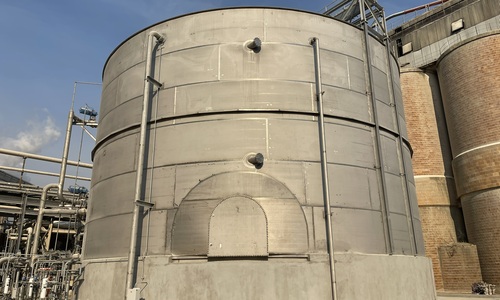Duplex Stainless Steel Storage Tanks & Pressure Vessels
Duplex stainless steel is a subset of stainless steels. The name “duplex” is derived from the material’s metallurgical structure consisting of two phases: austenite and ferrite in near similar proportions. The material provides better corrosion resistance, particularly chloride stress corrosion and chloride pitting corrosion, as well as higher strength than typical 300 series stainless steels, including 304 and 316 grades.
Compared with austenitic stainless steel, duplex stainless steel has a higher chromium content (20–28%), higher molybdenum (up to 5%), lower nickel (up to 9%), and .05–.50% nitrogen. The unique microstructure, with its balanced austenite and ferrite phases, provides exceptional strength and corrosion resistance, often at a lower cost than comparable alloys.
Tate Metalworks utilizes duplex stainless steel in both field-erected and shop-fabricated tanks to provide enhanced durability and reliability for a variety of applications.
Benefits of Duplex Stainless Steel
We've been fabricating API storage tanks and ASME Pressure Vessels from duplex stainless steels for decades. Our clients choose this material grade for the following reasons:
High strengthThe high tensile strength allows for thinner materials, reducing weight and potentially lowering fabrication costs for applications where structural integrity and strength are critical. |
Corrosion resistantThe unique combination of chromium and molybdenum provides exceptional resistance to localized corrosion, like. pitting and crevice corrosion, as well as stress corrosion cracking, which can be problematic for other types of stainless steels. |
Tough and ductileNickel additions enhance toughness, maintaining performance even at low temperatures and making it suitable for diverse environments, including marine and offshore. |
Cost efficientIn many applications, duplex stainless steels offer a cost-effective alternative to nickel alloys and other high-performance materials due to their lower nickel content and comparable performance. |
Versatile applicationsThey are used in a variety of industries, including oil and gas, chemical processing, pulp and paper, desalination plants and marine environments, due to their combination of strength, corrosion resistance and cost-effectiveness. |
Ease of fabricationThey are relatively easy to fabricate and weld compared to some other high-alloy steels, which simplifies manufacturing processes and reduces costs. |
Tate's Expertise
Tate Metalworks fabricates and erects API-650 and API-620 storage tank sand ASME pressure vessels from both lean duplex materials—S32101 (2101), S32304 (2304), S32202 (2202)—and duplex materials—S31803, S32205 (2205), S32750 (2750). With decades of experience fabricating and erecting these tanks and pressure vessels, we have developed dozens of proven weld procedures for joining duplex materials.
All of our duplex weld procedures adhere to ASME Section IX Welding Code. Key components to maintaining the material’s strength and corrosion resistance properties include careful control of heat input, travel speed, and interpass temperature. During the development of our dozens of duplex welding procedures, Tate Metalworks has utilized post-weld impact testing, tensile testing, corrosion testing and ferrite testing as per industry and code standards. Our high standards and expertise assure our clients that the investments they've made for API storage tanks and ASME pressure vessels will serve them well for years to come.
Our duplex weld procedure includes:
- Ferrite content measurement: Duplex stainless steels require a balanced ferrite-austenite ratio to achieve optimum properties. Ferrite content measurement using techniques such as ferritescope or magnetic induction is critical to ensure the weld has the desired ferrite content, which affects mechanical and corrosion properties.
- Corrosion testing: They are tested for their resistance to various corrosion types, such as pitting corrosion and stress corrosion cracking. Testing methods include exposure to corrosive environments (e.g., salt spray testing), electrochemical methods (e.g., potentiodynamic polarization), and immersion testing.
- Mechanical testing: Mechanical testing evaluates the strength, toughness, and ductility of welds. Tensile testing, impact testing, and hardness testing are common methods used to assess mechanical properties and ensure they meet specified requirements.
Understanding Duplex Stainless Steel Properties
Duplex stainless steel is known for its unique microstructure, a balanced blend of austenite and ferrite phases. This dual-phase composition gives it a reliable combination of strength, weldability and corrosion resistance.
Key Alloying Elements
- Chromium and Molybdenum: These elements are ferrite formers that promote strength and increase corrosion resistance, especially against chloride-induced corrosion.
- Nickel and Nitrogen: These elements are austenite formers that enhance toughness and ductility. They also contributing to corrosion resistance and strength.
Chemical Composition of Duplex Stainless Steel Grades
The table below shows the percentage ranges of key elements in various grades, highlighting how these compositions influence the material's properties.
| Chromium (%) | Nickel (%) | Molybdenum (%) | Nitrogen (%) | |
| 2101 | 21 - 22 | 1.35 - 1.7 | .1 - .8 | .2 - .25 |
| 2304 | 21.5 - 24.5 | 3 - 5.5 | .05 - .6 | .05 - .2 |
| 2205 | 22 - 23 | 4.5 - 6.5 | 3 - 3.5 | .14 - .2 |
| 2507 | 24 - 26 | 6 - 8 | 3 - 5 | .24 - .32 |
Note: Numbers represent the max unless a range is given.
The Importance of Phase Balance
The near-equal proportions of austenite and ferrite phases in duplex stainless steel are crucial for achieving its optimal properties. This balance ensures a combination of high strength, good toughness and superior corrosion resistance.
PREN: Predicting Corrosion Resistance
The Pitting Resistance Equivalent Number (PREN) is a calculated value used to estimate a stainless steel's resistance to pitting corrosion. Higher PREN values generally indicate better resistance to this type of corrosion.
|
|
Min Tensile Strength (KSI) |
Min Yield Strength (KSI) |
Max Hardness (HBW) | PREN |
| 2101 | 94 | 65 | 290 | 26.585 |
| 2304 | 87 | 58 | 290 | 26.072 |
| 2205 | 95 | 65 | 293 | 35.945 |
| 2507 | 116 | 80 | 310 | 42.68 |
Note: PREN calculation based on average of the range for chemical content.
Tate's Welding Process
Step 1) Pre-weld preparation
Proper cleaning and preparation of the base metal are crucial to prevent contamination. Remove any oil, grease, scale, or surface oxides that could affect the weld quality.
Step 2) Welding process
Duplex stainless steels can be welded using various processes such as gas tungsten arc welding (GTAW/TIG), gas metal arc welding (GMAW/MIG), shielded metal arc welding (SMAW/stick), and flux-cored arc welding (FCAW). The choice of process depends on the thickness of the material and the specific requirements of the application.
Step 3) Filler material
Selecting the correct filler material is critical to achieve the desired properties in the weld. Typically, matching or overmatching filler metals with high chromium, molybdenum, and nitrogen content are used to ensure corrosion resistance and mechanical properties similar to the base metal.
Step 4) Welding parameters
Control welding parameters such as heat input, interpass temperature, and travel speed to minimize the risk of sensitization and distortion. Duplex stainless steels are sensitive to thermal cycles, so maintaining proper heat control is essential.
Step 5) Post-weld heat treatment
In some cases, post-weld heat treatment (PWHT) may be required to reduce residual stresses and improve the corrosion resistance of the weldment. However, duplex stainless steels generally require less PWHT compared to austenitic stainless steels.
Step 6) Avoiding sensitization
Duplex stainless steels can be susceptible to sensitization, where the formation of chromium carbides reduces corrosion resistance in the heat-affected zone (HAZ). Proper welding procedures and filler materials with low carbon content help minimize this risk.
Step 7) Testing and inspection
Conduct thorough testing and inspection of welds to ensure they meet specified requirements for mechanical properties and corrosion resistance. Non-destructive testing (NDT) methods, such as ultrasonic testing (UT), dye penetrant testing (PT), and Ferrite testing, are commonly used.
Step 8) Welding sequence
Plan the welding sequence to minimize distortion and control the cooling rate to avoid cracking. Back purging with inert gas (e.g., argon) during welding can help prevent oxidation and maintain the correct composition in the weld.

Tate partners with clients to meet their needs through quality design and construction.
We collaborate with various industries to produce steel and alloy plate structures such as industrial storage tanks, pressure vessels, stacks, silos and more.
© 2026 Tate Metalworks. All Rights Reserved|
Privacy | Cookies |
Site by ALINE, A Marketing Company





 Tate serves clients Nationwide, from our Headquarters in the Upstate of South Carolina.
Tate serves clients Nationwide, from our Headquarters in the Upstate of South Carolina.